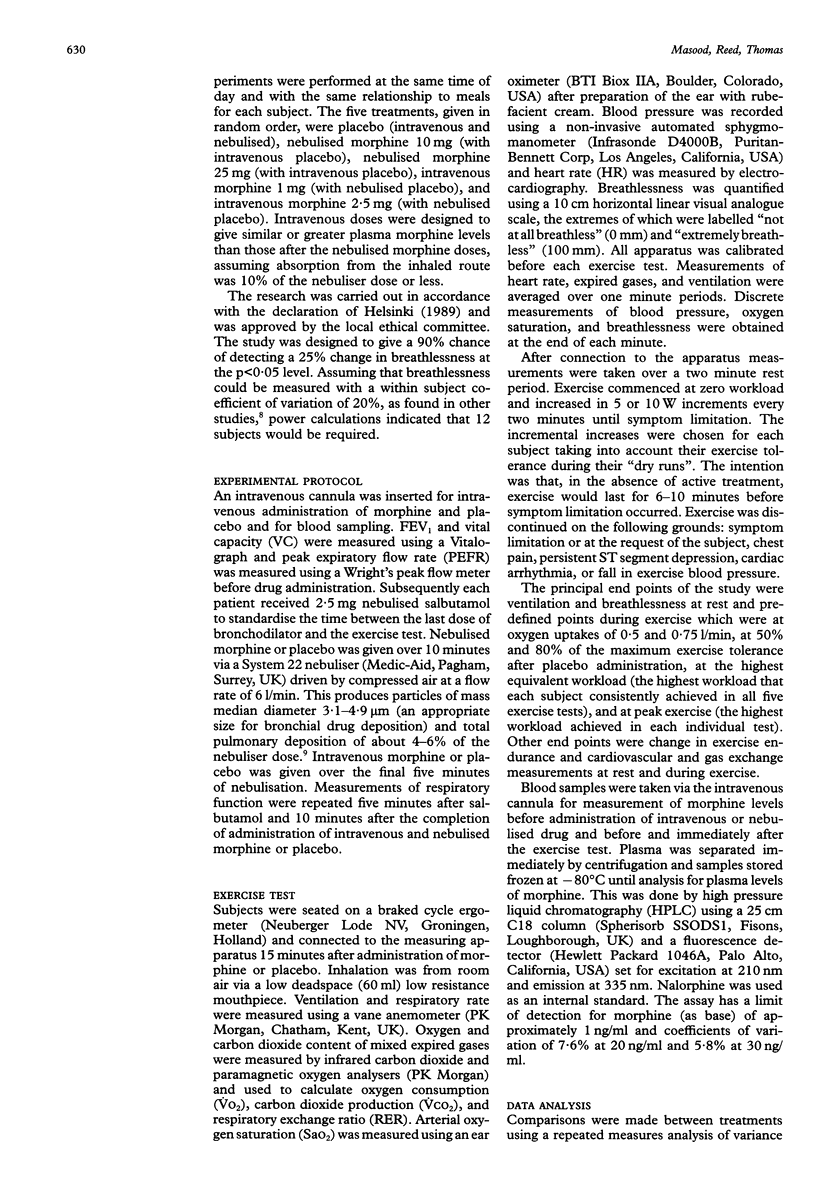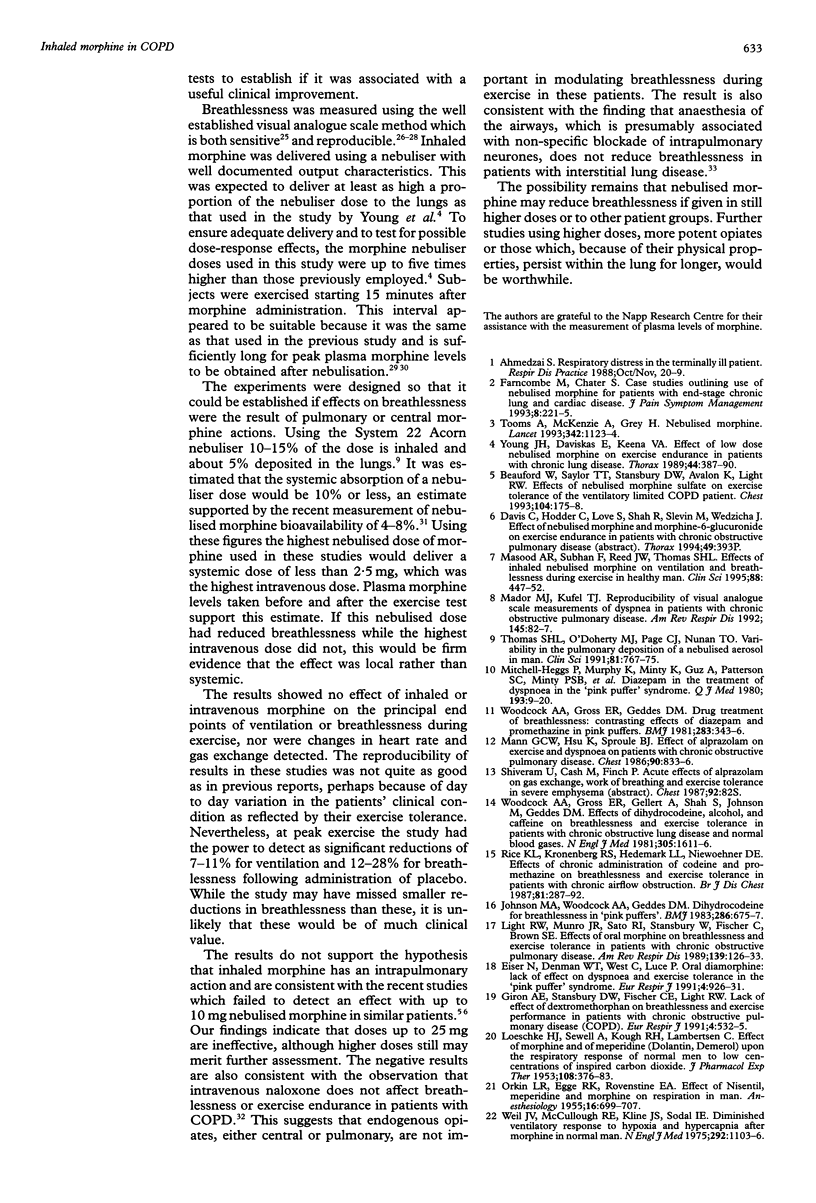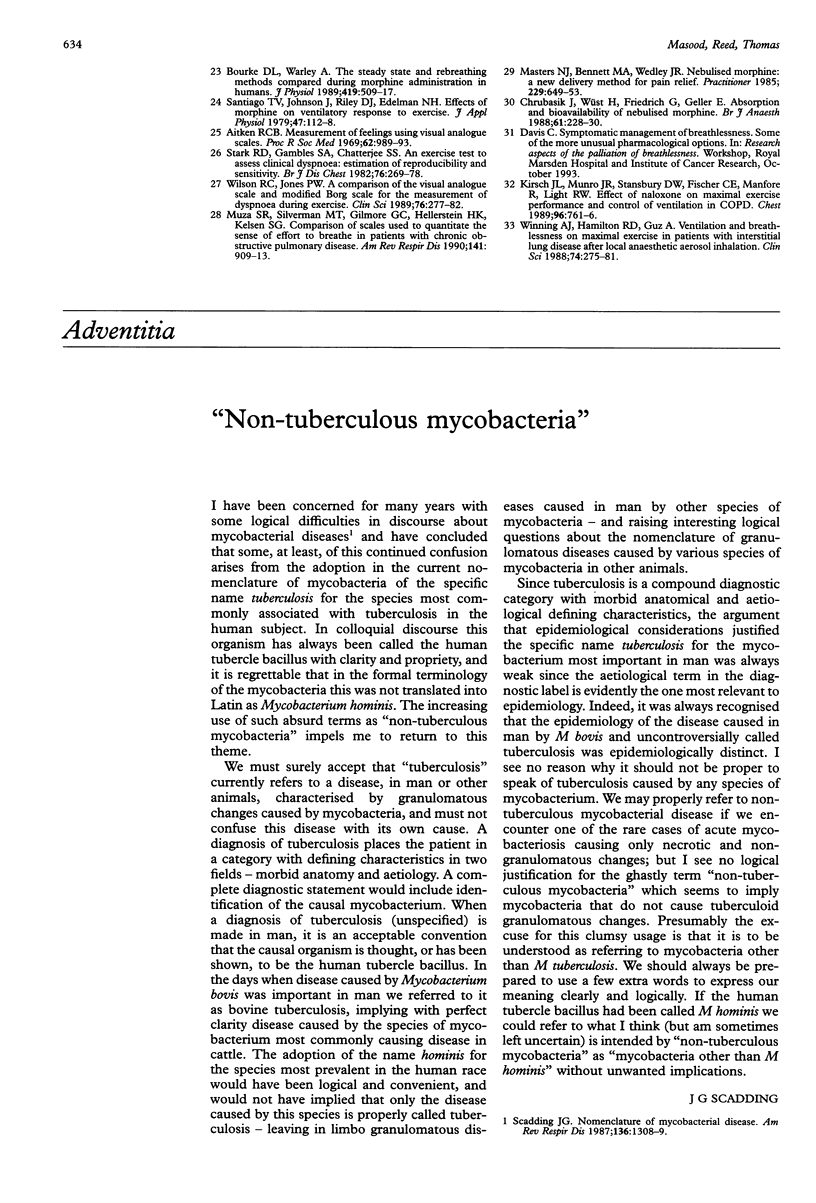Abstract
BACKGROUND--Inhaled nebulised morphine may reduce breathlessness in patients with lung disease, although the results of controlled trials are conflicting. A direct action of morphine on the lung has been postulated. This study aimed to investigate whether nebulised morphine reduced exercise-induced breathlessness in patients with chronic obstructive pulmonary disease (COPD) and to determine if this was a local pulmonary effect or occurred after systemic morphine absorption. METHODS--A double blind, randomised, crossover study was performed in 12 men with COPD to compare the effects of nebulised morphine (10 and 25 mg), equivalent intravenous doses (1 and 2.5 mg), and placebo. Breathlessness (visual analogue scale), ventilation, gas exchange, and exercise endurance were measured during graded bicycle exercise. RESULTS--None of the treatments altered breathlessness, ventilation, or gas exchange at rest or at any time during exercise, and exercise endurance was unaffected. At peak exercise mean (95% CI) changes from placebo in ventilation were -0.8 (-0.57 to 1.1) l/min and -0.4 (-2.8 to 2.0) l/min for the highest intravenous and nebulised doses, respectively. For breathlessness equivalent values were +2 (-5 to 9) and +1 (-9 to 11) mm. The study was of sufficient power that it is unlikely that a clinically important effect was missed. CONCLUSIONS--Nebulised morphine in these doses has no effect on exercise-induced breathlessness. These findings do not support the hypothesis that intrapulmonary opiates modulate the sensation of breathlessness in patients with COPD.
Full text
PDF





Selected References
These references are in PubMed. This may not be the complete list of references from this article.
- Aitken R. C. Measurement of feelings using visual analogue scales. Proc R Soc Med. 1969 Oct;62(10):989–993. [PMC free article] [PubMed] [Google Scholar]
- Beauford W., Saylor T. T., Stansbury D. W., Avalos K., Light R. W. Effects of nebulized morphine sulfate on the exercise tolerance of the ventilatory limited COPD patient. Chest. 1993 Jul;104(1):175–178. doi: 10.1378/chest.104.1.175. [DOI] [PubMed] [Google Scholar]
- Bourke D. L., Warley A. The steady-state and rebreathing methods compared during morphine administration in humans. J Physiol. 1989 Dec;419:509–517. doi: 10.1113/jphysiol.1989.sp017883. [DOI] [PMC free article] [PubMed] [Google Scholar]
- Charbonneau G., Sudraud M., Racineux J. L., Meslier N., Tuchais E. Forced expirations in normal subjects. Is the shape of the flow rate curve related to existence of a wheeze? Chest. 1987 Nov;92(5):825–831. doi: 10.1378/chest.92.5.825. [DOI] [PubMed] [Google Scholar]
- Chrubasik J., Wüst H., Friedrich G., Geller E. Absorption and bioavailability of nebulized morphine. Br J Anaesth. 1988 Aug;61(2):228–230. doi: 10.1093/bja/61.2.228. [DOI] [PubMed] [Google Scholar]
- Demedts M., De Man F. Circulating immune complexes in chronic eosinophilic pneumonia. Acta Clin Belg. 1991;46(2):75–81. doi: 10.1080/17843286.1991.11718146. [DOI] [PubMed] [Google Scholar]
- Eiser N., Denman W. T., West C., Luce P. Oral diamorphine: lack of effect on dyspnoea and exercise tolerance in the "pink puffer" syndrome. Eur Respir J. 1991 Sep;4(8):926–931. [PubMed] [Google Scholar]
- Farncombe M., Chater S. Case studies outlining use of nebulized morphine for patients with end-stage chronic lung and cardiac disease. J Pain Symptom Manage. 1993 May;8(4):221–225. doi: 10.1016/0885-3924(93)90131-e. [DOI] [PubMed] [Google Scholar]
- Giron A. E., Stansbury D. W., Fischer C. E., Light R. W. Lack of effect of dextromethorphan on breathlessness and exercise performance in patients with chronic obstructive pulmonary disease (COPD). Eur Respir J. 1991 May;4(5):532–535. [PubMed] [Google Scholar]
- Hashimoto Y., Ino T., Kramer P. J., Naylor A. W., Strain B. R. Dynamic analysis of water stress of sunflower leaves by means of a thermal image processing system. Plant Physiol. 1984 Sep;76(1):266–269. doi: 10.1104/pp.76.1.266. [DOI] [PMC free article] [PubMed] [Google Scholar]
- Johnson M. A., Woodcock A. A., Geddes D. M. Dihydrocodeine for breathlessness in "pink puffers". Br Med J (Clin Res Ed) 1983 Feb 26;286(6366):675–677. doi: 10.1136/bmj.286.6366.675. [DOI] [PMC free article] [PubMed] [Google Scholar]
- Kirsch J. L., Muro J. R., Stansbury D. W., Fischer C. E., Monfore R., Light R. W. Effect of naloxone on maximal exercise performance and control of ventilation in COPD. Chest. 1989 Oct;96(4):761–766. doi: 10.1378/chest.96.4.761. [DOI] [PubMed] [Google Scholar]
- LOESCHCKE H. H., SWEEL A., KOUGH R. H., LAMBERTSEN C. J. The effect of morphine and of meperidine (dolantin, demerol) upon the respiratory response of normal men to low concentrations of inspired carbon dioxide. J Pharmacol Exp Ther. 1953 Jul;108(3):376–383. [PubMed] [Google Scholar]
- Light R. W., Muro J. R., Sato R. I., Stansbury D. W., Fischer C. E., Brown S. E. Effects of oral morphine on breathlessness and exercise tolerance in patients with chronic obstructive pulmonary disease. Am Rev Respir Dis. 1989 Jan;139(1):126–133. doi: 10.1164/ajrccm/139.1.126. [DOI] [PubMed] [Google Scholar]
- Mador M. J., Kufel T. J. Reproducibility of visual analog scale measurements of dyspnea in patients with chronic obstructive pulmonary disease. Am Rev Respir Dis. 1992 Jul;146(1):82–87. doi: 10.1164/ajrccm/146.1.82. [DOI] [PubMed] [Google Scholar]
- Masood A. R., Subhan M. M., Reed J. W., Thomas S. H. Effects of inhaled nebulized morphine on ventilation and breathlessness during exercise in healthy man. Clin Sci (Lond) 1995 Apr;88(4):447–452. doi: 10.1042/cs0880447. [DOI] [PubMed] [Google Scholar]
- Masters N. J., Bennett M. R., Wedley J. R. Nebulised morphine: a new delivery method for pain relief. Practitioner. 1985 Jul;229(1405):649-50, 653. [PubMed] [Google Scholar]
- Mitchell-Heggs P., Murphy K., Minty K., Guz A., Patterson S. C., Minty P. S., Rosser R. M. Diazepam in the treatment of dyspnoea in the 'Pink Puffer' syndrome. Q J Med. 1980 Winter;49(193):9–20. [PubMed] [Google Scholar]
- Muza S. R., Silverman M. T., Gilmore G. C., Hellerstein H. K., Kelsen S. G. Comparison of scales used to quantitate the sense of effort to breathe in patients with chronic obstructive pulmonary disease. Am Rev Respir Dis. 1990 Apr;141(4 Pt 1):909–913. doi: 10.1164/ajrccm/141.4_Pt_1.909. [DOI] [PubMed] [Google Scholar]
- ORKIN L. R., EGGE R. K., ROVENSTINE E. A. Effect of nisentil, meperidine and morphine on respiration in man. Anesthesiology. 1955 Sep;16(5):699–707. doi: 10.1097/00000542-195509000-00007. [DOI] [PubMed] [Google Scholar]
- Rice K. L., Kronenberg R. S., Hedemark L. L., Niewoehner D. E. Effects of chronic administration of codeine and promethazine on breathlessness and exercise tolerance in patients with chronic airflow obstruction. Br J Dis Chest. 1987 Jul;81(3):287–292. doi: 10.1016/0007-0971(87)90163-x. [DOI] [PubMed] [Google Scholar]
- Santiago T. V., Johnson J., Riley D. J., Edelman N. H. Effects of morphine on ventilatory response to exercise. J Appl Physiol Respir Environ Exerc Physiol. 1979 Jul;47(1):112–118. doi: 10.1152/jappl.1979.47.1.112. [DOI] [PubMed] [Google Scholar]
- Stark R. D., Gambles S. A., Chatterjee S. S. An exercise test to assess clinical dyspnoea: estimation of reproducibility and sensitivity. Br J Dis Chest. 1982 Jul;76(3):269–278. [PubMed] [Google Scholar]
- Thomas S. H., O'Doherty M. J., Page C. J., Nunan T. O. Variability in the measurement of nebulized aerosol deposition in man. Clin Sci (Lond) 1991 Dec;81(6):767–775. doi: 10.1042/cs0810767. [DOI] [PubMed] [Google Scholar]
- Tooms A., McKenzie A., Grey H. Nebulised morphine. Lancet. 1993 Oct 30;342(8879):1123–1124. doi: 10.1016/0140-6736(93)92113-8. [DOI] [PubMed] [Google Scholar]
- Weil J. V., McCullough R. E., Kline J. S., Sodal I. E. Diminished ventilatory response to hypoxia and hypercapnia after morphine in normal man. N Engl J Med. 1975 May 22;292(21):1103–1106. doi: 10.1056/NEJM197505222922106. [DOI] [PubMed] [Google Scholar]
- Wilson R. C., Jones P. W. A comparison of the visual analogue scale and modified Borg scale for the measurement of dyspnoea during exercise. Clin Sci (Lond) 1989 Mar;76(3):277–282. doi: 10.1042/cs0760277. [DOI] [PubMed] [Google Scholar]
- Winning A. J., Hamilton R. D., Guz A. Ventilation and breathlessness on maximal exercise in patients with interstitial lung disease after local anaesthetic aerosol inhalation. Clin Sci (Lond) 1988 Mar;74(3):275–281. doi: 10.1042/cs0740275. [DOI] [PubMed] [Google Scholar]
- Woodcock A. A., Gross E. R., Geddes D. M. Drug treatment of breathlessness: contrasting effects of diazepam and promethazine in pink puffers. Br Med J (Clin Res Ed) 1981 Aug 1;283(6287):343–346. doi: 10.1136/bmj.283.6287.343. [DOI] [PMC free article] [PubMed] [Google Scholar]
- Woodcock A. A., Gross E. R., Gellert A., Shah S., Johnson M., Geddes D. M. Effects of dihydrocodeine, alcohol, and caffeine on breathlessness and exercise tolerance in patients with chronic obstructive lung disease and normal blood gases. N Engl J Med. 1981 Dec 31;305(27):1611–1616. doi: 10.1056/NEJM198112313052703. [DOI] [PubMed] [Google Scholar]
- Young I. H., Daviskas E., Keena V. A. Effect of low dose nebulised morphine on exercise endurance in patients with chronic lung disease. Thorax. 1989 May;44(5):387–390. doi: 10.1136/thx.44.5.387. [DOI] [PMC free article] [PubMed] [Google Scholar]


